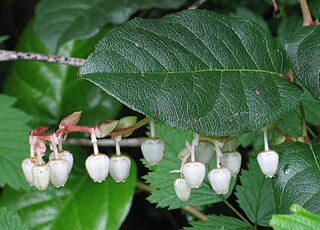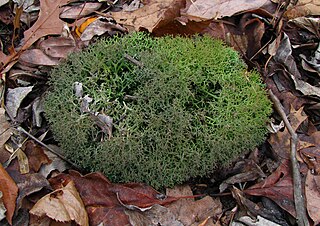
Gaultheria shallon is an evergreen shrub in the heather family (Ericaceae), native to western North America. In English, it is known as salal, shallon, or gaultheria.

Polystichum munitum, the western swordfern, is an evergreen perennial fern native to western North America, where it is one of the most abundant ferns in forested areas. It occurs along the Pacific coast from southeastern Alaska to southern California, and also inland east to southeastern British Columbia, northern Idaho and western Montana, with disjunctive populations in northern British Columbia, Canada; the Black Hills in South Dakota, United States; and Guadalupe Island off of Baja California, Mexico. Western swordfern is known to have locally naturalized in parts of Great Britain and Ireland.

Letharia vulpina, commonly known as the wolf lichen, is a fruticose lichenized species of fungus in the family Parmeliaceae. It is bright yellow-green, shrubby and highly branched, and grows on the bark of living and dead conifers in parts of western and continental Europe and the Pacific Northwest and northern Rocky Mountains of North America. This species is somewhat toxic to mammals due to the yellow pigment vulpinic acid, and has been used historically as a poison for wolves and foxes. It has also been used traditionally by many native North American ethnic groups as a pigment source for dyes and paints.

Xanthoparmelia chlorochroa, known as the tumbleweed shield lichen or ground lichen, is a foliose lichen in the Parmeliaceae family. It is not fixed to a substrate, and blows around in the wind from location to location.

Cladonia furcata or the many-forked cup lichen is a species of cup lichen in the family Cladoniaceae. It has an intermediate to tolerant air pollution sensitivity. Extracts of this species have been shown to kill leukemia cells in vitro, and may have possible value in the treatment of cancer.

Bryoria is a genus of lichenized fungi in the family Parmeliaceae. Many members of this genus are known as horsehair lichens. The genus has a widespread distribution, especially in boreal and cool temperate areas.

Pilophorus acicularis, commonly known as the nail lichen or the devil's matchstick lichen, is a species of matchstick lichen in the family Cladoniaceae.
Stephen Sharnoff is a photographer, especially of botanical and lichen subjects. He specializes in close-up botanical color work. He is also a research associate at the University and Jepson Herbaria of the University of California, Berkeley and a past associate of the Missouri Botanical Garden.

A podetium is the upright secondary thallus in Cladonia lichens. It is a hollow stalk extending from the primary thallus. Podetia can be pointed stalks, club like, cupped, or branched in shape and may or may not contain the ascocarp, the fruiting body, of the lichen. It is not considered part of the primary thallus as it is a fruiting structure for reproduction.

In lichens, rhizines are multicellular root-like structures arising mainly from the lower surface. A lichen with rhizines is termed rhizinate, while a lichen lacking rhizines is termed erhizinate. Rhizines serve only to anchor the lichen to their substrate; they do not absorb nutrients, as plant roots do. Characteristics of the rhizines are used to identify lichens, for example, whether they are dense or sparse, uniformly distributed or clumped in specific areas, and straight or branched. Only foliose lichens may possess rhizines, not crustose or fruticose lichens, which lack a lower cortex.

Leucolepis acanthoneura is a species of moss in the family Mniaceae. It is known as leucolepis umbrella moss or Menzies' tree moss. It is endemic to the Pacific Coast in Canada and the United States.

Rhizomnium is a genus of mosses in the family Mniaceae commonly referred to as leafy mosses. They grow nearly worldwide, mostly in the northern hemisphere.

Rhizomnium glabrescens, also called fan moss or large leafy moss, is a species of moss in the genus Rhizomnium.
Bruce Pettit McCune is an American lichenologist, botanist, plant ecologist, and software developer for analysis of ecological data.

Letharia columbiana is a common lichen in subalpine forests, particularly in the Pacific Northwest of the United States, and parts of Canada. It is in the family Parmeliaceae, and the genus Letharia. Its characteristics include a bright citron color, “brown-eyes”, and rounded, irregular branches. Though previously believed to lump together several lineages such as Letharia gracilis and others, there now exists more specific characteristics to identify the species. This lichen grows on the bark of conifers a couple inches tall. L. Columbiana’s cousin, Letharia vulpina (common name wolf lichen), has similar geographical distribution and morphological features, with the major difference being the “brown-eyes” of L. columbiana.

Lobaria anomala, commonly known as the netted specklebelly, is a species of foliose lichen in the family Peltigeraceae. It is found in coastal western North America, where it grows on trees in humid environments. The lichen was first described as a new species in 1987 as a species of Pseudocyphellaria, though it had been mentioned in scientific papers before.

Peltigera cinnamomea, commonly known as the cinnamon-pelt lichen, is a muscicolous (moss-dwelling), leafy lichen in the family Peltigeraceae. The Canadian lichenologist Trevor Goward formally described the species in 1995. The lichen is found in northwestern North America's forested regions, particularly in the unique montane and subalpine forest communities of the northern Rocky Mountains. Peltigera cinnamomea grows under prolonged snow cover, surviving well into spring. This trait distinguishes it from many other Peltigera species in similar North American forest ecosystems.

Umbilicaria angulata, commonly known as the asterisk rocktripe, is a species of saxicolous (rock-dwelling), foliose lichen in the family Umbilicariaceae. It is found in northwestern North America and east Eurasia, where it grows on acidic rock.

Tuckermannopsis orbata, commonly known as the variable wrinkle lichen, is a species of foliose lichen in the family Parmeliaceae. It is a small cetrarioid lichen, an informal growth form category that denotes lichens with erect, foliose thalli, and apothecia and pycnidia on the margins of the ruffled lobes. Tuckermannopsis orbata is found in Asia and North America, growing primarily on the wood and bark of mostly birch and coniferous tree branches and twigs.

Peltigera retifoveata is a species of foliose lichen in the family Peltigeraceae. It is found in Scandinavia, western Eurasia and western North America, where it grows on the ground and amongst mosses.

















